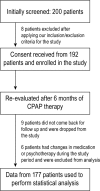Improving PTSD Symptoms and Preventing Progression of Subclinical PTSD to an Overt Disorder by Treating Comorbid OSA With CPAP
- PMID: 28859723
- PMCID: PMC5612635
- DOI: 10.5664/jcsm.6770
Improving PTSD Symptoms and Preventing Progression of Subclinical PTSD to an Overt Disorder by Treating Comorbid OSA With CPAP
Abstract
Study objectives: Obstructive sleep apnea (OSA) and posttraumatic stress disorder (PTSD) are common in United States veterans. These conditions often coexist and symptoms overlap. Previous studies reported improvement in PTSD symptoms with continuous positive airway pressure (CPAP) therapy for comorbid OSA but its effect has not been assessed in a non-PTSD cohort. We have prospectively assessed the effect of CPAP therapy on clinical symptom improvement as a function of CPAP compliance levels among PTSD and non-PTSD veterans.
Methods: Veterans in whom OSA was newly diagnosed were enrolled in our study (n = 192). Assignment to PTSD and non-PTSD cohorts was determined by chart review. Each patient completed the military version of the PTSD Checklist (PCL), Epworth Sleepiness Scale (ESS), and reported nightmare frequency (NMF) at baseline and 6 months after CPAP therapy. CPAP adherence was objectively documented from machine compliance data.
Results: We had complete data for 177 veterans (PTSD n = 59, non-PTSD n = 118) for analysis. The mean ages were 51.24 years in the PTSD cohort and 52.36 years in the non-PTSD cohort (P = .30). In the PTSD cohort, the mean total PCL score (baseline = 66.06, post-CPAP = 61.27, P = .004, d = -0.34) and NMF (baseline = 4.61, post-CPAP = 1.49, P = .0001, d = -0.51) decreased after 6 months of CPAP treatment. Linear regression analysis showed that the CPAP compliance was the only significant predictor for these changes among veterans with PTSD (PCL score: P = .033, R2 = .65; NMF; P = .03, R2 = .61). Further analysis by CPAP compliance quartiles in this cohort (Q1 = 0% to 25%, Q2 = 26% to 50%, Q3 = 51% to 75%, Q4 > 75%) revealed that mean total PCL score declined in Q2 (change = -3.91, P = .045, d = 0.43), Q3 (change = -6.6, P = .002, d = 0.59), and Q4 (change = -7.94, P = .037, d = 0.49). In the non-PTSD cohort, the PCL score increased despite CPAP therapy in lower CPAP compliance quartiles Q1 (change = 8.71, P = .0001, d = 0.46) and Q2 (change = 4.51, P = .046, d = 0.27). With higher CPAP compliance (in Q3 and Q4) in this cohort, the mean total PCL scores slightly improved with CPAP but they were not statistically significant (P > .05).
Conclusions: CPAP treatment reduces total PCL score and NMF in veterans with PTSD and OSA. Those with overt PTSD respond to even lower CPAP compliance, whereas non-PTSD patients require higher compliance to achieve any symptom improvement. Poor CPAP compliance results in increased PCL score in non-PTSD veterans and may lead to overt PTSD if the OSA remains undertreated.
Commentary: A commentary on this article appears in this issue on page 1121.
Keywords: CPAP; OSA; PTSD; veterans.
© 2017 American Academy of Sleep Medicine
Figures



Comment in
-
Post-Freudian PTSD: Breath, the Protector of Dreams.J Clin Sleep Med. 2017 Oct 15;13(10):1121-1122. doi: 10.5664/jcsm.6750. J Clin Sleep Med. 2017. PMID: 28942766 Free PMC article. No abstract available.
References
-
- Haynes SN, Adams A, Franzen M. The effects of presleep stress on sleep-onset insomnia. J Abnorm Psychol. 1981;90(6):601–606. - PubMed
-
- Morin CM, Rodrigue S, Ivers H. Role of stress, arousal, and coping skills in primary insomnia. Psychosom Med. 2003;65(2):259–267. - PubMed
-
- Utzon-Frank N, Breinegaard N, Bertelsen M, et al. Occurrence of delayed-onset post-traumatic stress disorder: a systematic review and meta-analysis of prospective studies. Scand J Work Environ Health. 2014;40(3):215–229. - PubMed
-
- American Psychiatric Association. Diagnostic and Statistical Manual of Mental Disorders. 5th ed. Arlington, VA: American Psychiatric Association; 2013.
MeSH terms
LinkOut - more resources
Full Text Sources
Other Literature Sources
Medical

